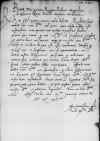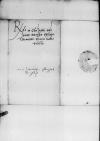Reverende in Christo Pater, sincere nobis dilecte.
Redditae sunt nobis ⌊⌋ Vestrae Paternitatis, ad quas, quia epistula nostra est responsiva, non oportet nos multa in praesens scribere, praeter hoc unum, quod nos, ea quae superinscribed⌈quaequae superinscribed⌉ Paternitati Vestrae scripsimus, scripsimus ex animo bono ac sincero atque ex eo zelo, quo Paternitatem Vestram in eo loco, in quo est, esse voluimus. Nihilque in his, quae ei scripsimus, nec ab aequanimitate, nec a decoro nostro defleximus, praesertim quod videamus, quod omnes fere actiones, quae coram sacra ⌊regia maiestate⌋ fiunt, aliter postea istic invertantur. Offendi non debet Vestra Paternitas nec succensere, quod illam submonemus, ut honorem et dignitatem sacrae ⌊regiae maiestatis⌋ Vestra Paternitas in suo loco custodiret. Honor etenim ac dignitas ⌊maiestatis suae⌋ praeponi ante omnia debet, ex quo postea honor ipsius Vestrae Paternitatis et aliorum dependet.
Bene valeat Paternitas Vestra.


 BCz, 1601, p. 680
BCz, 1601, p. 680